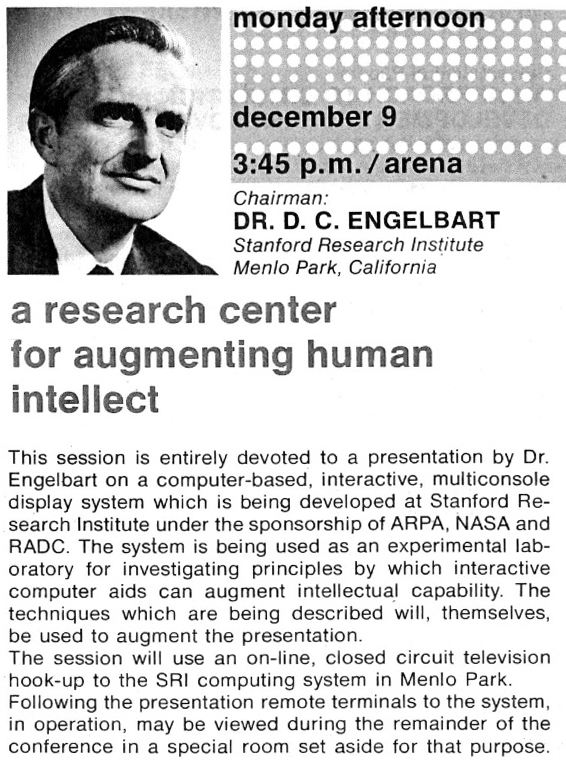Our company CTO, David Smith, has been the principle architect of Croquet since the beginning. Long before that, he wrote the first commercial 3D game for a personal computer. Here’s some video (made with an actual video camera on old Mac) of how The Colony looked in 1987.
Tag: personal computer
The Mother of All Demos
I was able to go to the 40th Anniversary celebration of “The Mother of All Demos.” The 1968 live demo is most famous for introducing its hardware, including the mouse, but it was quite a bit more than that…

The Imagination Age
This month’s Tech Review has an editorial that begins “Inventing the future…” and end with these two paragraphs:
“Traditionally, Technology Review hasn’t written that much about society. Our subject matter is emerging technologies, and they have historically been purchased by corporations, universities, and governments. That’s because emerging technologies used to require an extraordinary capital investment, one well beyond the means of most people in their private capacities. Nor did most people see the need to experiment with really novel technologies. Thus the personal computer, the local-area network, the Internet itself were all first used in commercial, government, or academic settings.
”But this is changing. The spread of cheap laptops, handheld devices, affordable Internet access, Wi-Fi, and a dozen other consumer technologies has led to a wonderful explosion of new social applications for them. But here’s the really interesting thing: most of these social technologies have simple editing and programming tools that let ordinary folks do innovative things that risk-averse corporations and government agencies would be hesitant to try. We suspect that Technology Review will be writing about the impact of new technologies on society much more frequently. Besides, social technologies are more fun.”
Here’s the letter to the editors that I just sent:
components
The computer spreadsheet doesn’t get enough credit among computer programmers. I think that more than any other one concept, VisiCalc, 1-2-3, and Excel were the killer app for the personal computer. As a programmer, I have tended first to think of formulae and calculation mechanisms when I think of spreadsheets, but the UI and development style are perhaps more significant. For each individual cell, you can look at the value, the formula, or the formatting, and change each through a menu. You can incrementally build up quite a complex application all on your own, never leaving the very environment you use to view the results. Why doesn’t all software work this way, only better? That’s what I’m working on.
The Mother of All Demos
I was able to go to the 40th Anniversary celebration of “The Mother of All Demos.” The 1968 live demo is most famous for introducing its hardware, including the mouse, but it was quite a bit more than that…

The Imagination Age
This month’s Tech Review has an editorial that begins “Inventing the future…” and end with these two paragraphs:
“Traditionally, Technology Review hasn’t written that much about society. Our subject matter is emerging technologies, and they have historically been purchased by corporations, universities, and governments. That’s because emerging technologies used to require an extraordinary capital investment, one well beyond the means of most people in their private capacities. Nor did most people see the need to experiment with really novel technologies. Thus the personal computer, the local-area network, the Internet itself were all first used in commercial, government, or academic settings.
”But this is changing. The spread of cheap laptops, handheld devices, affordable Internet access, Wi-Fi, and a dozen other consumer technologies has led to a wonderful explosion of new social applications for them. But here’s the really interesting thing: most of these social technologies have simple editing and programming tools that let ordinary folks do innovative things that risk-averse corporations and government agencies would be hesitant to try. We suspect that Technology Review will be writing about the impact of new technologies on society much more frequently. Besides, social technologies are more fun.”
Here’s the letter to the editors that I just sent:
components
The computer spreadsheet doesn’t get enough credit among computer programmers. I think that more than any other one concept, VisiCalc, 1-2-3, and Excel were the killer app for the personal computer. As a programmer, I have tended first to think of formulae and calculation mechanisms when I think of spreadsheets, but the UI and development style are perhaps more significant. For each individual cell, you can look at the value, the formula, or the formatting, and change each through a menu. You can incrementally build up quite a complex application all on your own, never leaving the very environment you use to view the results. Why doesn’t all software work this way, only better? That’s what I’m working on.



